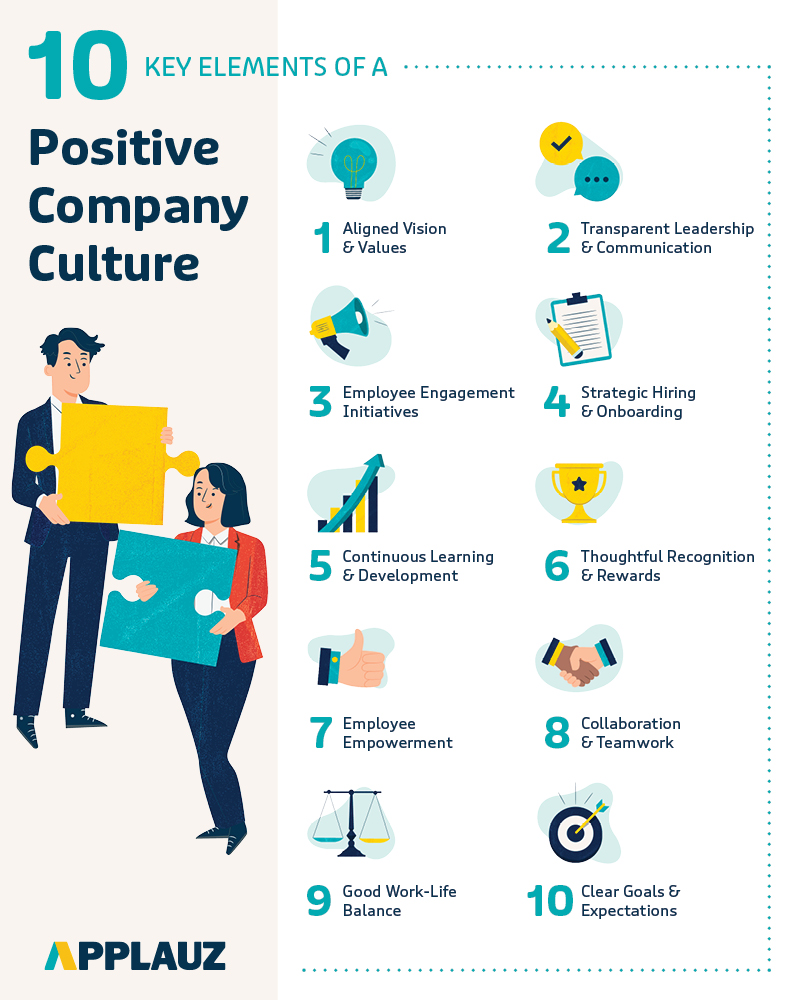
Building a Strong Company Culture: Your Blueprint for Success
In today’s fast-paced business world, simply having a great product or service isn’t enough. To truly thrive, companies need something more – something that binds their teams together, fuels innovation, and keeps everyone rowing in the same direction. That "something" is a strong company culture.
But what exactly is company culture? Think of it as your company’s personality, its DNA, or the invisible force that shapes how people interact, make decisions, and feel about their work. It’s not just about ping-pong tables or free snacks; it’s about the shared values, beliefs, attitudes, and practices that define your workplace.
If you’re a business owner, a manager, or even an employee wondering how to make your workplace better, this article is for you. We’ll break down what it takes to build a powerful company culture, step by step, in language anyone can understand.
What Exactly Is Company Culture?
Before we dive into building it, let’s make sure we’re on the same page. Company culture is:
- The unspoken rules: How people really get things done, not just what’s written in the employee handbook.
- Shared values: What your company believes in and stands for (e.g., innovation, customer-first, integrity, teamwork).
- Behavioral norms: How employees are expected to act towards each other, customers, and partners.
- The "feel" of the workplace: Is it collaborative or competitive? Relaxed or high-pressure? Fun or serious?
- How decisions are made: Is it top-down, or are employees empowered to contribute?
- How conflicts are handled: Are they addressed openly, or swept under the rug?
In short, it’s "how things are done around here." And it happens whether you actively build it or not. The goal is to build it intentionally.
Why a Strong Company Culture Matters (A Lot!)
Building a strong culture isn’t just a nice-to-have; it’s a strategic necessity. Here’s why it’s worth your time and effort:
- Attracts and Retains Top Talent: In a competitive job market, people aren’t just looking for a paycheck. They want a place where they feel valued, respected, and where they can grow. A great culture acts like a magnet for the best people and encourages them to stay.
- Boosts Employee Engagement and Productivity: When employees feel connected to the company’s mission and values, they’re more motivated, happier, and more productive. They go the extra mile because they want to, not just because they have to.
- Fosters Innovation and Creativity: A culture that encourages open communication, experimentation, and learning from mistakes creates a safe space for new ideas to flourish. Employees feel comfortable sharing thoughts, leading to breakthrough solutions.
- Improves Customer Satisfaction: Happy employees lead to happy customers. When your team feels good about their work and their company, it shows in how they interact with clients, leading to better service and stronger relationships.
- Builds a Strong Brand Reputation: Your company culture isn’t just internal; it spills over. A positive culture can lead to great word-of-mouth, positive reviews, and a reputation as an employer of choice.
- Increases Resilience and Adaptability: In times of change or crisis, a strong culture provides a stable foundation. Employees who trust each other and share common goals are better equipped to navigate challenges together.
The Blueprint: How to Build a Strong Company Culture
Building a robust company culture isn’t an overnight task. It’s an ongoing journey that requires commitment from everyone, especially leadership. Here are the key steps:
1. Define Your Core Values and Mission
This is the absolute bedrock of your culture. Your values are the fundamental beliefs that guide your company’s actions and decisions.
- What to do:
- Identify 3-5 core values: Don’t just pick buzzwords. Think about what truly matters to your company. Are they integrity, innovation, customer focus, teamwork, transparency, excellence?
- Make them actionable: Instead of just "Integrity," explain what that looks like in daily work (e.g., "We do the right thing, even when no one is watching").
- Communicate them constantly: Display them, talk about them in meetings, use them in performance reviews. They shouldn’t just be words on a wall.
- Connect to a Mission: What is the ultimate purpose of your company? Your mission statement should inspire and unite your team.
2. Lead by Example (Culture Starts at the Top!)
No matter how many perks you offer, if leaders don’t embody the desired culture, it won’t stick. Authenticity is key.
- What to do:
- Walk the talk: If you value transparency, be transparent. If you value work-life balance, don’t send emails at 11 PM every night.
- Be consistent: Your actions should always align with the values you promote.
- Communicate openly: Share company news, challenges, and successes. Be approachable and willing to listen.
- Show empathy: Understand your employees’ perspectives and challenges.
3. Foster Open and Honest Communication
A culture of trust and psychological safety thrives on clear, consistent, and two-way communication.
- What to do:
- Encourage feedback: Create safe channels for employees to share ideas, concerns, and feedback without fear of reprisal. This could be regular surveys, anonymous suggestion boxes, or open-door policies.
- Be transparent: Share company goals, progress, and even challenges. The more employees know, the more invested they feel.
- Regular check-ins: Managers should have regular one-on-one meetings with their team members, not just to discuss tasks, but also well-being and career growth.
- Utilize multiple channels: Use meetings, emails, internal chat platforms, and company-wide announcements to keep everyone informed.
4. Prioritize Employee Well-being and Growth
When employees feel cared for, they perform better and are more loyal. This goes beyond just health benefits.
- What to do:
- Support work-life balance: Encourage employees to take breaks, use their vacation time, and avoid burnout. Consider flexible work arrangements.
- Invest in development: Offer training, workshops, mentorship programs, and opportunities for skill development. Show them you care about their future.
- Promote health: Encourage physical and mental well-being through resources, initiatives, or simply by fostering a supportive environment.
- Career pathing: Help employees see a future for themselves within the company.
5. Recognize and Reward Contributions
People want to feel appreciated for their hard work. Recognition reinforces positive behaviors and motivates others.
- What to do:
- Be specific and timely: Don’t just say "good job." Explain what they did well and why it mattered. Recognize efforts as soon as possible.
- Vary recognition: It doesn’t always have to be monetary. Public praise, a thank-you note, a small gift, a shout-out in a meeting – all can be effective.
- Connect to values: When recognizing someone, link their actions back to your company’s core values. This reinforces the culture.
- Peer recognition: Empower employees to recognize each other’s contributions.
6. Embrace Diversity, Equity, and Inclusion (DEI)
A strong culture is one where everyone feels they belong, are valued, and have an equal opportunity to succeed.
- What to do:
- Recruit broadly: Actively seek candidates from diverse backgrounds, experiences, and perspectives.
- Foster an inclusive environment: Ensure all voices are heard, and different viewpoints are respected. Create a safe space for everyone.
- Educate and train: Provide training on unconscious bias and cultural sensitivity.
- Celebrate differences: Recognize and celebrate the unique backgrounds and experiences that each employee brings to the table.
7. Encourage Collaboration and Teamwork
Break down silos and foster an environment where people enjoy working together towards common goals.
- What to do:
- Create shared goals: Ensure teams understand how their work contributes to the bigger picture.
- Design collaborative spaces: Physical or virtual spaces that encourage interaction and shared problem-solving.
- Promote cross-functional projects: Get people from different departments working together.
- Celebrate team successes: Recognize collective achievements, not just individual ones.
8. Gather Feedback and Adapt
Culture isn’t static; it evolves. Regularly check its pulse and be willing to make changes.
- What to do:
- Conduct regular culture surveys: Ask employees about their experience, what’s working, and what could be improved.
- Hold stay interviews: Ask high-performing employees why they stay with the company.
- Analyze exit interviews: Learn why people leave and identify patterns that might point to cultural issues.
- Act on feedback: Most importantly, show employees that their feedback is heard and acted upon. This builds trust.
Common Culture Building Mistakes to Avoid
Even with the best intentions, companies can stumble. Watch out for these pitfalls:
- "Culture by Accident": Not actively defining or managing your culture means it will form on its own, often not in the way you want.
- Ignoring Feedback: Asking for input but then doing nothing about it will quickly breed cynicism and disengagement.
- Lack of Leadership Buy-in: If leaders don’t genuinely commit to and embody the culture, employees won’t take it seriously.
- Focusing Only on Perks: While perks are nice, they are not culture. They are temporary motivators if the underlying values and behaviors aren’t strong.
- Inconsistent Application: Applying cultural rules or values unevenly (e.g., leaders get away with behaviors employees are punished for) destroys trust.
- One-Size-Fits-All Approach: What works for one team or department might not work for another. Be flexible while maintaining core values.
Measuring and Maintaining Your Culture
Building a strong company culture is an ongoing process. It requires constant nurturing and evaluation.
-
Key Metrics to Watch:
- Employee Retention Rates: Are people staying? High turnover can be a red flag.
- Employee Engagement Scores: Regular surveys can track how connected and motivated your team feels.
- Absenteeism Rates: High rates might indicate stress or low morale.
- Internal Promotion Rates: A sign of growth opportunities within the company.
- Candidate Applications: Are you attracting a high volume of quality applicants?
-
Keep it Alive:
- Onboarding: Integrate your culture into the onboarding process from day one.
- Regular Reinforcement: Keep talking about your values, celebrating successes, and addressing challenges.
- Adaptation: As your company grows and the world changes, your culture might need to evolve too. Be open to it.
Conclusion: Your Company’s Greatest Asset
Building a strong company culture isn’t just a buzzword; it’s an investment in your people, your productivity, and your long-term success. It’s about creating a place where employees feel valued, empowered, and excited to contribute their best work every day.
By defining your values, leading by example, fostering open communication, prioritizing well-being, and continuously adapting, you can cultivate a thriving environment that attracts top talent, boosts performance, and sets your business apart. Start today – your company’s future depends on it!



Post Comment